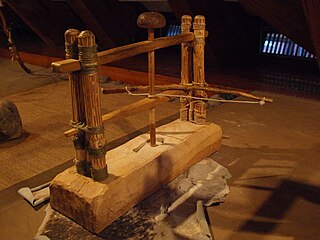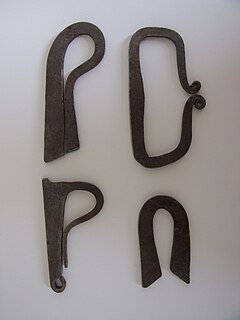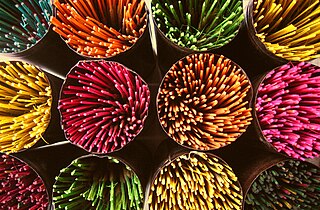
A bow drill is a simple rotational hand-operated tool of prehistoric origin. As a "fire drill" it was commonly used to generate friction to start a fire. With time it was adapted to woodworking and other tasks that require drilling, such as dentistry.

Incense is aromatic biotic material that releases fragrant smoke when burned. The term is used for either the material or the aroma. Incense is used for aesthetic reasons, aromatherapy, meditation, and ceremony. It may also be used as a simple deodorant or insect repellent.

A campfire is a fire at a campsite that provides light and warmth, and heat for cooking. It can also serve as a beacon, and an insect and predator deterrent. Established campgrounds often provide a stone or steel fire ring for safety. Campfires are a popular feature of camping. At summer camps, the word campfire often refers to an event at which there is a fire. Some camps refer to the fire itself as a campfire.
A hockey stick is a piece of sport equipment used by the players in all the forms of hockey to move the ball or puck either to push, pull, hit, strike, flick, steer, launch or stop the ball/puck during play with the objective being to move the ball/puck around the playing area using the stick, and then trying to score.

The manipulation of the devil stick is a form of gyroscopic juggling or equilibristics, consisting of manipulating one stick between one or two other sticks held one in each hand. The baton is lifted, struck, or stroked by the two control sticks, stabilizing the baton through gyroscopic motion.

Tinder is easily combustible material used to start a fire. Tinder is a finely divided, open material which will begin to glow under a shower of sparks. Air is gently wafted over the glowing tinder until it bursts into flame. The flaming tinder is used to ignite kindling, which in turn is used to ignite the bulk material, to produce a fire.

In archaeology and anthropology, a digging stick, or sometimes yam stick, is a wooden implement used primarily by subsistence-based cultures to dig out underground food such as roots and tubers or burrowing animals and anthills. The stick may also have other uses in hunting or general domestic tasks.

Yut Nori, also known as Yunnori, Nyout, and Yoot, is a traditional board game played in Korea, especially during Korean New Year. The game is also called cheok-sa or sa-hee. The combining-form -nori means 'game'.

The davul, tapan, atabal or tabl is a large double-headed drum that is played with mallets. It has many names depending on the country and region. These drums are commonly used in the music of Middle East. These drums have both a deep bass sound and a thin treble sound due to their construction and playing style, where different heads and sticks are used to produce different sounds on the same drum.

Fire making, fire lighting or fire craft is the process of artificially starting a fire. It requires completing the fire triangle, usually by heating tinder above its autoignition temperature.

A fire striker is a piece of carbon steel from which sparks are struck by the sharp edge of flint, chert or similar rock. It is a specific tool used in firemaking.

Char cloth, also called char paper, is a material that is used as tinder when lighting a fire and is the main component in a tinderbox. It is a small swatch of fabric made from a natural fibre, such as linen, cotton or jute, that has been converted through the method of pyrolysis into a slow-burning fuel of very low ignition temperature. Pyrolysis is defined as "a thermochemical decomposition of organic material at elevated temperatures in the absence of oxygen”. Although this material is usually made from swatches of organic fabrics, campers and outdoor enthusiasts have also discovered that a similar tinder can be made in the same way using cotton balls or tampons. This material when properly prepared will ignite with the slightest spark, making it very popular with campers, especially in harsh weather conditions when lighting a fire is more difficult as it has a very low auto ignition temperature of 349 °C - 455 °C. Applying the same principle that has been used throughout history by indigenous peoples, char cloth can help start a fire with only the help of flint and steel, it is then placed in a tinder bundle and blown into flames. It is easily made on a small scale making it accessible and popular in the domestic sphere and while cooking on campfires.

An ice hockey stick is a piece of equipment used in ice hockey to shoot, pass, and carry the puck across the ice. Ice hockey sticks are approximately 150–200 cm long, composed of a long, slender shaft with a flat extension at one end called the blade. National Hockey League (NHL) sticks are up to 63 inches long. The blade is the part of the stick used to contact the puck, and is typically 25 to 40 cm long. Stick dimensions can vary widely, as they are usually built to suit a particular player's size and preference. The blade is positioned at roughly a 135° angle from the axis of the shaft, giving the stick a partly 'L-shaped' appearance. The shaft of the stick is fairly rigid, but is slightly elastic to improve shot performance.

In India, incense sticks, also called Agarbatti, are a large part of the economy and many religions in the region.

A fire plough is a firelighting tool. In its simplest form, it is two sticks rubbed together. Rubbing produces friction and heat, and eventually an ember. More advanced are "stick-and-groove" forms, which typically uses a V-shaped base piece of wood, and a "friction stick" as the activator.

Charcoal is a lightweight black carbon residue produced by strongly heating wood in minimal oxygen to remove all water and volatile constituents. In the traditional version of this pyrolysis process, called charcoal burning, the heat is supplied by burning part of the starting material itself, with a limited supply of oxygen. The material can also be heated in a closed retort.

A walking stick or walking cane is a device used primarily to aid walking, provide postural stability or support, or assist in maintaining a good posture, but some designs also serve as a fashion accessory, or are used for self-defense.

Shaving soap is a hard soap that is used to produce lather with a shaving brush. The lather it produces is used to coat the face during shaving, softening the hair in preparation for shaving.

This is an alphabetized glossary of terms pertaining to lighting fires, along with their definitions. Firelighting is the process of starting a fire artificially. Fire was an essential tool in early human cultural development. The ignition of any fire, whether natural or artificial, requires completing the fire triangle, usually by initiating the combustion of a suitably flammable material.

Wanám,, were a group of Amerindians once native to the region of southern Rondônia in Brazil. They lived on the Cautarinho, Sao Miguel and Manoel rivers near their confluence with the Guaporé. Around 1914 there were 300 Wanám. The rubber booms of the twentieth century destroyed the tribe because of the violence and diseases brought in by neo-Brazilians. The surviving Wanám went to live with neighboring groups Kabixí living on the São Miguel River. Although the Wanám people did not survive, their language did, at least among the Kabixí Indians.


















